Driven to distraction - how Mad Max is dropping a bomb on the open-world
Look up and over the wrecked particles of civilisation, across the shattered landscape once hidden beneath a long since vapourised sea. To the north you’ll see a thick column of dark smoke, a constant blemish wedged between horizon and sky. This is Gastown, an oil refinery that burns day and night with an abandon only possible in a world where the threat of global warming really isn’t an issue any more.
It’s Mad Max’s Mount Doom, an ever-present, visible reminder of where you should be going and who you should be fighting. Only this goal isn’t home to some majestic dark lord. No, Gastown is ruled by a man who calls himself Scrotus.
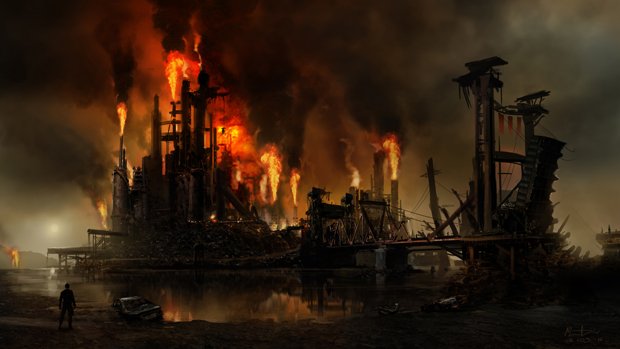
But he's going to have to wait - I just noticed an eight-car convoy, and I really want to fuck that up first.
“There is this narrative arc,” says game director Frank Rooke, “but the game will get you off track almost immediately. It distracts you so much that you’ll end up saying, ‘Er, I’m just going to go over here and do this.’ You can’t help yourself – there are so many things to go off and do.”
Avalanche is no stranger to playing in a sandbox – its Just Cause series is built on the ‘what will happen if I do this?’ feeling – but with Mad Max, the Stockholm studio’s built what could be its most literal one yet. Not constrained by being a true tie-in – the game takes both the original Mad Max trilogy and the upcoming reboot as inspiration, but has its own world and story – the team’s post-apocalyptic desert is anything but deserted, bursting at the seams with violence, exploration and no-fooling maniacs.
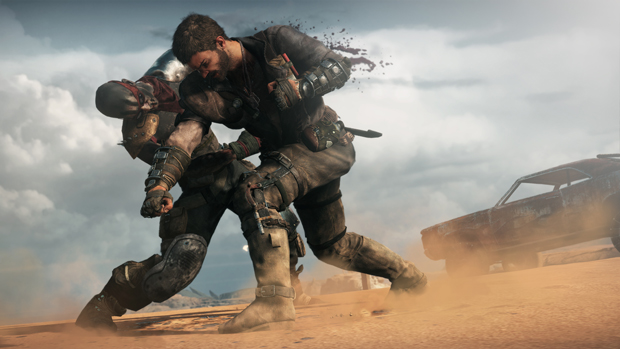
It’s an open-world experience that we recognise, but one that doesn’t aim for Assassin’s Creed’s map-saturating, no-effort points of interest. It’s more a case that wherever you go, something’s always happening, or you can make something happen. Every time you think you’re heading off to do one thing, you’ll likely end up being distracted by something entirely different.
We start our demo driving out of a beached, exploding tanker ship in a rusty muscle car, with a screeching hunchback in the back. Somehow, things build from here. Within minutes we’re attaching our car’s harpoon to watchtowers and dragging their screaming occupants to the ground, hijacking trucks full of precious scrap and high-tailing it back to a stronghold safe haven, or initiating impromptu eight-on-one destruction derbies. The majority of the game’s best moments seem to be spent in the driver’s seat.
Weekly digests, tales from the communities you love, and more

That’s not surprising – this is a game, and a film series, obsessed with the primal thrum of an engine. It all begins with Max having his precious Interceptor forcibly taken from him – no better way of putting a loving middle finger up to the films that featured his signature car. The storyline then centres around him building a new patchwork masterpiece, the Magnum Opus, with the help of a deformed mechanical whizz called Chumbucket (names are clearly not Wastelanders’ strong suit). But even your V8-powered centrepiece is a sandbox in itself.
“The Magnum Opus gives the player a blank canvas,” explains senior game designer Alex Williams. “It’s almost a skeleton at the beginning of the game, then it’s up to you to create your own unique war machine. We’ve got tons of upgrades, and each one has pros and cons. There’s no optimal car, so it’s really up to you to do activities in the open world, do missions for different people so that you can build your car to fit your own play style. Like any car game, we want you tinkering.”
"The post-apocalyptic desert is anything but deserted, bursting at the seams with violence, exploration and no-fooling maniacs."
That feeling, that in among the usual tangle of open-world systems sits a proper driving game, is our favourite part of Mad Max so far. The cars are meticulously designed, with a laser focus on the handling model and real-world physics of each one. Well-armoured vehicles are more sluggish, but ram with devastating force and become harder to roll. Faster, more vulnerable cars will suffer from direct contact, but make using secondary weapons (handled by Chumbucket in the back, with ultra slow-motion added to help your aim) feel more efficient and valuable.
Where most open-world car chases devolve into scrappy, hard-to-control, one-on-one contests, Avalanche has made something that feels more akin to the films the game is based on – drawn-out, adrenaline-rush gauntlets that have you sideswiping enemies into scenery, bursting tyres, avoiding hijackers and finally, triumphantly, watching your target explode in a huge cloud of scrap – which can then be used to make your car even better.

But, crucially, it’s not just a car game. While vehicular combat is the game’s biggest innovation, it draws from the best of its peers for on-ground sections. As you can imagine, the Wasteland is not rich in old-world ammo, meaning melee combat is the order of the aeon. The result is fights that see Max tackling enemies in Batman: Arkham-style bouts, the familiar rhythm of attacks and parries providing the bedrock, while grabbing dropped shivs and clubs offers some extra firepower – until they break.
Unlike his superhero counterpart, Max is more comfortable behind a wheel. He’s as burly as they come, but he’s not got the benefit of being a ninja-orphan with lots of spare time for training. He can’t vault across an entire room to hit someone ready to throw a spear into his back – evasion is as important as blocking in many situations. Some enemies are simply too tough to thump in normal fashion, meaning you’ll need to draw them into nearby traps, or simply wait for them to get exhausted. In a pinch, you can unload some of that precious shotgun ammo, which provides a risk/reward thrill – Max can’t move while he lines up a shot, Resident Evil style.

“It’s a brutal world,” says design director Magnus Nedfors. “We wanted to have a brutal fighting style. We didn’t want Max to be a martial artist. He’s almost a slugger; he’s gone through a lot of fighting in his life, so he’s learned combat through that.” And he continues to learn, as Nedfors points out: “You can build up your character, widen your arsenal. You can get more varied styles of combat, but also execution moves, learning how to use an opportunity in a fight to execute an enemy.” That need for opportunism is never clearer than in the game’s best ground sections – the camps. Nabbing from Far Cry, the Wasteland is peppered with pockets of feral humanity, makeshift homes, prisons, forts and scrap storage yards, built from whatever happened to be lying around. Taking one on is as much a question of preparation as it is execution.
Take our first conquest, a rusted oil-drilling platform that had since become the home of a nasty gang of Scrotus’ raiders. Arriving outside, we found a gate protected by two always-on flamethrowers, two snipers in watchtowers and three armed guards. The guards were easy – we turned them into a sandy paste with our car, before using a rocket launcher, the Thunderpoon (even weapons have bad names, apparently), to send one tower crashing into the other. Deactivating the flamethrowers involved following their gas lines to hidden tanks of fuel and turning them off in explosive fashion.
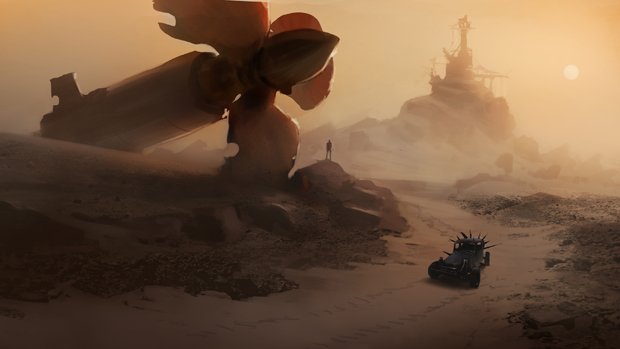
Once you’re finally inside the camp, things become a tad medieval – it’s as much castle combat as anything else. Courtyards let enemies stream in to overwhelm you, booby traps need to be decommissioned and there was even a fight up the spiral staircase leading to the top deck of the platform, like some bastardised take on that scene from Monty Python and the Holy Grail. Finally, there was a mini boss fight – after which the camp became ours, a constant stream of scrap our reward.
And that’s a single place, a single situation. As Frank Rooke explains, “A lot of effort – and expense, I should add – went into creating unique locations. It’s so easy to fall into the trap of creating templates and just popping them around. We couldn’t do that – everything had to feel like it was unique and fresh, made with purpose in that location, with its own story to tell. To me, that’s what makes it fun to go out and explore.”
Rooke says that, at last count, there are 200 unique locations in the game, every camp built to be part of the fabric of the Wasteland. It’s the biggest clue as to Avalanche’s hard work in making what could well have been an empty, brown landscape into something more appealing. While the reason for this apocalypse will never be revealed, the results of it are plain to see – the area you begin in is called the Great White, what used to be a seabed, proven by scattered oil rigs, softly undulating dunes and, most surreal of all, a broken-down lighthouse that acts as your first stronghold. Head north to what used to be a shore and things get darker, more industrial.
“We had to find a balance to portray a landscape that feels hostile and destroyed,” says art director Martin Bergquist, “but also with interesting locations, actual people living there – so that you want to go and explore. It comes from the layout of the landscape itself to the locations and how far apart they are from one another, so that they feel believable as well as fun.” The studio’s aim was to make the Wasteland as much a character as Max himself (and, to be fair, Max barely talks more than the landscape, so this isn’t quite as much a challenge as it might seem). The result’s a world that feels unpredictable, as quick to change on you as some thirsty soul in the desert looking to steal your stuff - weather conditions force you to change your plans, night-time (part of a two-hour day-night cycle) brings out entirely new enemies, even a lack of basic resources adds a light survival element.

The Magnum Opus needs fuel, and with the ability to carry only a single spare jerrycan in the trunk (plus the overwhelming desire to use that jerrycan as a makeshift grenade), you’ll need to keep track of where settlements are so as not to start sputtering in the middle of nowhere. Food and water, the only ways of replenishing a drained health bar, are scarce too – you’ll treasure both when you find them, even if it means watching Max scoff down maggots when you do.
These liabilities could seem like annoyances if their purpose wasn’t so clear – to lead you from the track once more. As Magnus Nedfors puts it: “When you run out of gas, it’s really just another step in the chain of gameplay. ‘Oh, I need to find something, so I’ll use my binoculars, mark things on the map and find the nearest source of fuel.’”
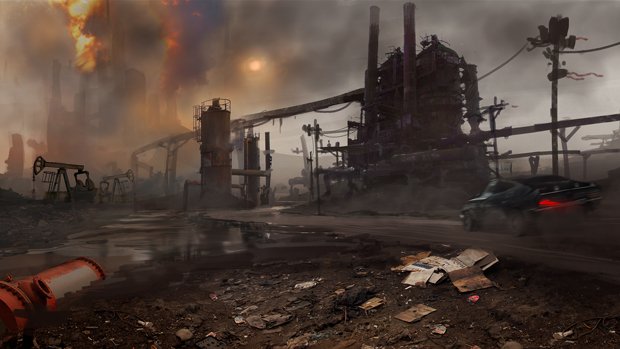
The game’s designed as a seamless series of events, from emergent vehicle chases that lead to on-ground combat when you crash, to a trudge through the desert for fuel that leads to discovering a wandering mission-giver, or a fight in a camp where you find a hauler covered in scrap. Every action can lead to another, endlessly, simultaneously sending you up upgrade trees, reaping rewards for simply playing how you want to. All of this is to ignore what we haven’t seen in action just yet – collectible car schematics, the Legend system, which turns achievement hunting into a stat-building exercise, upgradeable strongholds and, yes, the ability to unlock and care for a dog sidekick. More welcome distractions, basically.
“Everything out in the Wasteland is operating on its own terms,” says Rooke. “We’re not saying ‘there’s a car combat moment here’, ‘this person shows up there’ – it’s operating on its own rules. You may be driving around, nothing’s happening, getting a false sense of security, then all of a sudden a convoy shows up, and there are six or eight cars you have to deal with.
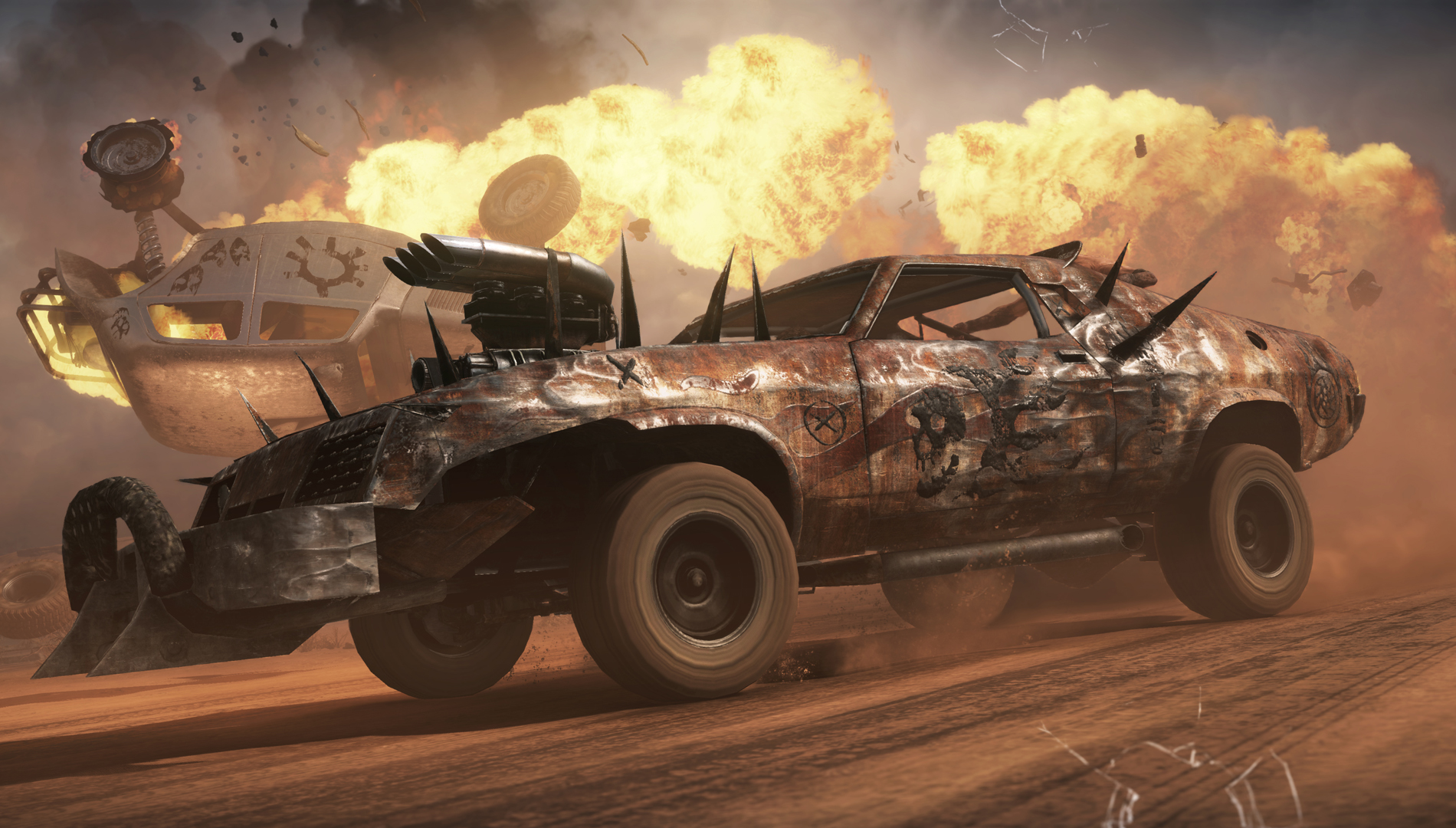
“Or you see something alongside the road, you jump out of your car to see if there’s something to scavenge, and a couple of guys jump out of the sand and all of a sudden you’re under attack. Then on top of that, a couple of snipers show up and start taking shots at you. Suddenly, you’re 20 feet away from your car, which is your safe haven, and that 20 feet seems like a very long way.”
The most exciting element of Mad Max at this point is that, after all of this, three more things could happen by the time you’ve covered those 20 feet - and who knows where they could lead? Time to face facts: we’re never going to get to Gastown, are we?



